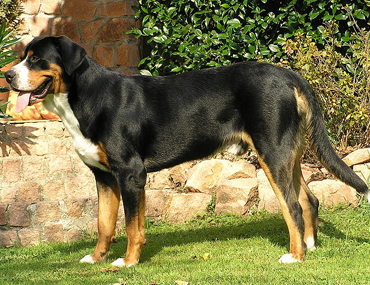Background:
Greater Swiss Mountain Dogs are members of the Sennenhunde family: the largest members in fact. Their origins are uncertain but most speculate this type of dog is descendent from the Molossian dogs of Rome which arrived in Switzerland during the invasion of the Alps over 2000 years ago. In Switzerland the breed was used for drafting, farm management, and as a watchdog. His size would certainly have been an advantage when pulling heavy carts.
In the early 1900s it was assumed that Greater Swiss Mountain Dogs had all died out. Industrialization had taken their jobs and sightings were nonexistent. However, in 1908 one such dog was entered into a competition where it immediately caught the eye of Professor Alfred Heim. Heim was a Sennenhunde enthusiast and campaigned to save the Greater Swiss Mountain Dog.
Although numbers did begin to rebound after that the breed was dealt another devastating blow during the Second World War as they had not yet migrated to America. The breed struggled to expand in the years following the war but has been going in the right direction.
G.S.M.D’s were recognized by the American Kennel Club in 1995.
Sizing up:
- Weight: 85 to 140 lbs.
- Height: 23.5 to 28.5 inches
- Coat: Short, dense
- Color: Black with rust and white markings
- Life Expectancy: 7-9 years
What’s the Greater Swiss Mountain Dog like?
Swiss Mountain Dogs are very social and will generally be friendly around both family and strangers. You should expect them to act like puppies for a long time because adulthood often comes slowly to large breeds. The long puppyhood also means they might be rambunctious and although they like children they could easily overwhelm them. Housetraining your Swissy can be difficult. You’ll need to have a lot of patience and you can’t leave them alone in the house until you’re sure they’re ready.
The Greater Swiss is a working dog and needs daily exercise. Cold weather is no excuse to skip the daily walk and if you do skip it the Swissy will become agitated and destructive. He would love to herd, but if that’s not an option a long walk will suffice. The Swissy does well in cold weather but can’t tolerate heat all that well so short walks and indoor playtime will be safer on hot days.
The Swissy has watchdog in his blood and will protect the family home, particularly from cats, which he’ll chase after as fast as he can. Make sure you keep him behind a fence when he’s not on a leash.
Health:
Although the Greater Swiss is reportedly healthier than most large breeds there are still conditions to watch for:
- Elbow dysplasia
- Panosteitis
- Distichiasis
- Gastric torsion
Takeaway Points:
- Greater Swiss Mountain Dogs are social dogs and crave interaction with people.
- Greater Swiss Mountain Dogs need to go outside and exercise, they also like the cold.
- Greater Swiss Mountain Dogs do best when they have room to run.
- Greater Swiss Mountain Dogs might knock children over during play time.
If you have any questions or concerns, you should always visit or call your veterinarian – they are your best resource to ensure the health and well-being of your pets.
